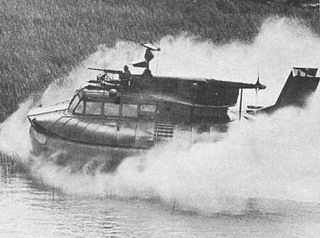
A hovercraft, also known as an air-cushion vehicle or ACV, is an amphibious craft capable of travelling over land, water, mud, ice, and other surfaces.

The SR.N4 hovercraft was a combined passenger and vehicle-carrying class of hovercraft. The type has the distinction of being the largest civil hovercraft to have ever been put into service.

Sir Christopher Sydney Cockerell CBE RDI FRS was an English engineer, best known as the inventor of the hovercraft.
Saunders-Roe Limited, also known as Saro, was a British aero- and marine-engineering company based at Columbine Works, East Cowes, Isle of Wight.

British Hovercraft Corporation (BHC) was a British hovercraft manufacturer that designed and produced multiple types of vehicles for both commercial and civil purposes.
The Society of British Aerospace Companies, formerly Society of British Aircraft Constructors, known as SBAC, was the UK's national trade association representing companies supplying civil air transport, aerospace defence, homeland security and space. As of October 2009 SBAC merged with the Defence Manufacturers Association and the Association of Police and Public Security Suppliers to form the ADS Group.
Hovertravel is a ferry company operating from Southsea, Portsmouth to Ryde, Isle of Wight, UK. It is the only passenger hovercraft company currently operating in Britain since Hoverspeed stopped using its craft in favour of catamarans and subsequently ceased all ferry operations in 2005.

The Saunders-Roe SR.N1 was the first practical hovercraft. The concept has its origins in the work of British engineer and inventor Christopher Cockerell, who succeeded in convincing figures within the services and industry, including those within British manufacturer Saunders-Roe. Research was at one point supported by the Ministry of Defence; this was later provided by the National Research Development Corporation (NRDC), who had seen the potential posed by such a craft.
Seaspeed was a British hovercraft operator which ran services in the Solent and English Channel between 1965 and 1981, when it merged with a rival to form Hoverspeed.

Hoverlloyd operated a cross-Channel hovercraft service between Ramsgate, England to Calais, France.
The Czilim-class ACV is a small patrol hovercraft operated by the Border Guard Service of Russia.

The Saunders-Roe SR.N6 hovercraft was essentially a larger version of the earlier SR.N5 series. It incorporated several features that resulted in the type becoming one of most produced and commercially successful hovercraft designs in the world.

The British Hovercraft Corporation AP1-88 is a medium-size hovercraft. In a civil configuration, the hovercraft can seat a maximum of 101 passengers, while as a troop carrier, it can transport up to 90 troops. When operated as a military logistics vehicle, the AP1-88 can carry a pair of Land Rovers, a Bv202 tracked vehicle and trailer unit or up to roughly 10 tons (10,000 kg) of cargo.

The Griffon 2000 series is a light-weight hovercraft built in the United Kingdom by Griffon Hoverwork and used principally by military and rescue organisations.

The Saunders-Roe SR.N5 was a medium-sized hovercraft which first flew in 1964. It has the distinction of being the first production-built hovercraft in the world.

The British Hovercraft Corporation BH.7 was a medium size hovercraft. It was the first quantity-production hovercraft to be specifically developed for military applications.

Tracked Hovercraft was an experimental high speed train developed in the United Kingdom during the 1960s. It combined two British inventions, the hovercraft and linear induction motor, in an effort to produce a train system that would provide 250 mph (400 km/h) inter-city service with lowered capital costs compared to other high-speed solutions. Substantially similar to the French Aérotrain and other hovertrain systems of the 1960s, Tracked Hovercraft suffered a similar fate to these projects when it was cancelled as a part of wide budget cuts in 1973.
Maurice Joseph Brennan BSC, MIMechE, FRAes was a British aerospace engineer. His career encompassed the design and development of flying boats before the Second World War to rocket powered fighters after. He had a significant role in Britain's first indigenous rocket project and in the development of practical hovercraft (SR.N1)
The Royal Navy maintains a number of Naval Parties worldwide to support a number of operations and training activities:












